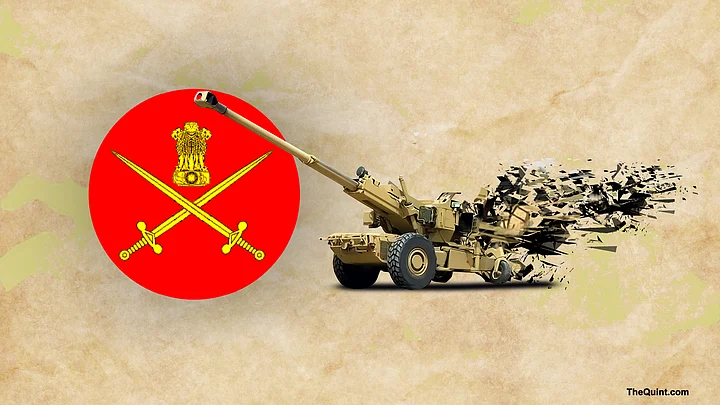Even as tensions on the Line of Control (LoC) continue to rise, the letter of offer and acceptance (LoA) received by the Ministry of Defence (MoD) from the Pentagon for the sale of 145 M777 howitzers to India expired on 5 November 2016.
The howitzer has a range of 24 km and weighs 4,000 kg. Its acquisition would have been the first addition to the artillery’s arsenal since 400 units of the Bofors FH-77B 155 mm/39-calibre howitzer were acquired in the mid-1980s.
Also Read: Indian Army Fraught with Shortage of Arms, Ailing Fighter Planes
M777 Howitzer Deal
The Defence Acquisition Council (DAC) has accorded approval to the acquisition of 145 units of 155 mm/39-calibre M777 howitzers for equipping seven medium regiments in the mountains. However, the negotiations with the US Department of Defence have not yet succeeded. The acquisition of the M777 weapon system, manufactured by US-based BAE Systems, will be through the Foreign Military Sales (FMS) route in a government-to-government deal.
In keeping with the government’s efforts to boost the ‘Make in India’ initiative, 120 units out of 145 are to be assembled in India. The deal has been reportedly stuck for lack of agreement on the offsets obligations and hike in the price intimated by the US government to Congress from $647 million to $737 million.
Also, as India was taking too long to decide, some of the factories involved in the manufacture of the M777 had begun to close down. Hence, if the letter of offer and acceptance is extended, it will take a few years before all the guns are delivered. This gun will be able to move between sectors when the C-47 Chinook medium-lift helicopter is also acquired. Acquisition of the Chinook helicopters is at an advanced stage of negotiation.
NDA Fares Better Than UPA
After a decade of neglect under the two UPA regimes, military modernisation is gradually picking up pace under the NDA government.
The Defence Acquisition Council has accorded acceptance of necessity (AoN) approval to modernisation projects worth over Rs 1,50,000 crore. Most of the newly approved weapons systems will be procured with transfer of technology (ToT) and manufactured in India. Or, where feasible, the weapon systems will be completely indigenously designed, developed and manufactured.
Modernisation of the artillery has been neglected for over two decades. This, despite the lessons learnt during the Kargil conflict of 1999, in which sustained artillery firepower had undeniably paved the way to victory. Firepower and manoeuvre are generally considered the two complementary sides of the coin that represent basic battlefield tactics. If the military aim is to be achieved in a future conflict, India’s firepower capabilities must be enhanced by an order of magnitude as only limited manoeuvre will be possible.
Obsolete Weapons
The artillery is now equipped with weapons and equipment that are becoming obsolete, like the 105 mm Indian Field Gun (IFG) and the 122 mm howitzer. Both of these need immediate replacement. The 130 mm Catapult self-propelled (SP) gun is too old to keep pace with modern armour. The 120 mm mortars have also reached obsolescence.
The artillery also requires large quantities of precision-guided munitions (PGMs) for the destruction of hard targets such as tanks and bunkers. A potent real-time reconnaissance, surveillance and target acquisition (RSTA) capability is also required.
And, in view of their performance in Afghanistan and Iraq, the time has come to add unmanned combat aerial vehicles (UCAVs) armed with precision-guided munitions to the artillery’s arsenal. Only then will it be possible to achieve future military aims and objectives. These include the large-scale destruction of the adversary’s war machinery.
Overhaul Needed
Under the army's Field Artillery Rationalisation Plan (FARP) formulated in 1999, the Regiment of Artillery had decided to standardise the calibre of its guns at 155 mm. This was done to enable the army to engage targets deep inside enemy lines and to reduce the logistics trail through the standardisation of ammunition. The artillery plans to acquire 2,820 guns of all types to replace obsolescent guns and to equip the new regiments that will form part of 17 Corps, the Mountain Strike Corps now under-raising.
Hurdles in Acquisition
The modernisation plan has been hit by the blacklisting of some firms in the fray. One example is that of the project for the acquisition of 180 units of 155 mm/52-calibre wheeled self-propelled (SP) guns. The tender was cancelled after the trials had already been completed. The contenders included Rheinmetal Defence of Germany and Konstrukta of the Slovak Republic. Fresh tenders were then issued. The primary contenders were the Teckwin ‘K-9 Thunder’ of Samsung, South Korea, that has now formed a joint venture (JV) with Larsen and Toubro (L&T), and the Russian Rosoboronexport’s tracked gun, which is an upgraded 155 mm version of the 152 mm MSTA-S SP gun.
(This is first part of a two-article series on the shortages of arms and ammunition facing the Indian Army)
(The writer is Distinguished Fellow, Institute for Defence Studies and Analyses (IDSA), and former Director, Centre for Land Warfare Studies (CLAWS), New Delhi. He can be reached at @gurmeetkanwal. This is an opinion piece and the views expressed above are the author’s own. The Quint neither endorses nor is responsible for the same.)
Also Read: 17 Years After Kargil, Army Only Has Ammo For Two Weeks’ Fight
